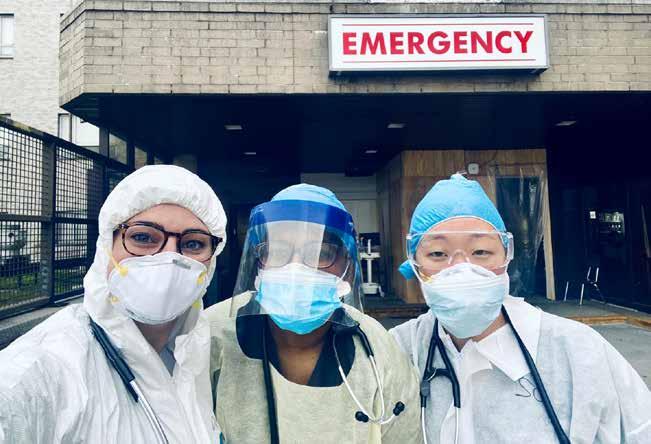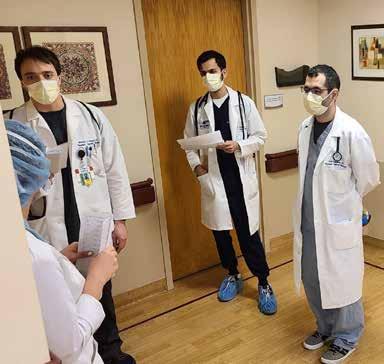
8 minute read
LECOM in the Epicenter
LECOM in the Epicenter Healthcare Community Responds to the Gravity of the Moment
Michael A. DiGiorno, DO, LECOM Regional Dean and Administrator of St. John's Riverside Hospital.
Physicians understand urgency. They train for urgent situations. They prepare for the worst case scenarios. Their minds – skilled, alert, and competently honed – comprehend the gravity of a moment.
For more than three grueling months, the medical teams at St. John’s Riverside Hospital in Yonkers, New York found themselves in the epicenter of the Coronavirus pandemic. St. John's Riverside Hospital is a Lake Erie College of Osteopathic Medicine (LECOM) regional campus staffed with a comprehensive network of medical professionals, including faculty and residents (many of them LECOM alumni and scholars) dedicated to a tradition of service that spans generations. The hospital is a leader in providing quality, compassionate health care utilizing the latest, state-of-the-art medical technology.
Several months ago, no one would have believed that the dire situation that happened in cities across the globe could happen in a place such as St. John’s Riverside Hospital. As the Coronavirus made its way into cities and towns across Europe, and the insidious disease became a pandemic, leadership at St. John's Riverside began preparing, and preparing vigorously.
Michael A. DiGiorno, DO, is a LECOM Regional Dean and an administrator at the hospital. He is a Class of 2000 LECOM graduate with more than 20 years of diverse experience, and he is board certified in internal medicine and nephrology. Dr. DiGiorno is charged with the integral role of advancing the LECOM education program.
As the rapidly evolving public health situation deteriorated, leadership at St. John’s implemented precautions to safeguard its patients and staff, including limiting access to areas deemed high risk for potential exposure. These areas included the emergency department and medical intensive care unit (ICU).
After consultation with clinical leadership at LECOM, St. John’s leadership decided to suspend clinical assignments for students on emergency medicine and medical ICU rotations for the remainder of the rotation block. LECOM students continued to attend all didactic conferences and workshops and maintained all aspects of an expanded online curriculum.
Clearly, something was brewing. One could feel it; the sense of urgency was bubbling just below the surface. Continual communication was underway between LECOM and principles at St. John’s Riverside Hospital. Ronald J. Corti, President and CEO of the St. John's Riverside Hospital teamed with Dr. DiGiorno to keep LECOM apprised of the daily changes.
As the LECOM students transitioned into remote access learning, limiting their potential exposure to the virus, their offsite training reduced the use of personal protective equipment (PPE), that the hospital staff would need desperately in the coming days.
As the situation devolved and New York State displayed the greatest number of Coronavirus cases in the country, Westchester County, (the county in which Yonkers is located), recorded the greatest number of cases in a single day, 98 out of 142 confirmed cases.
As St. John’s Riverside Hospital began to see a rapidly increasing number of upper respiratory infection cases in their emergency department and outpatient facilities, Dr. DiGiorno reached out to LECOM for support. “Despite strict policies on usage, we are struggling to maintain adequate stock of critical supplies, such as ventilators, surgical masks, hand sanitizer, and N-95 masks,” he wrote.
LECOM has a large number of clinical sites and affiliates, many of which were not facing the same virus numbers. LECOM began reaching out to assist in gathering supplies for St. John’s Riverside Hospital. “We know that every healthcare institution likely will face
– Continued from page 09

Coronavirus to some extent. If your LECOM sites are able to spare some of these supplies, we would be appreciative and work to ensure replacement or reimbursement of PPE as soon as possible,” Dr. DiGiorno explained.
The gravity in Dr. DiGiorno’s missive was evident. The LECOM administration immediately responded with supplies and PPE, and the urgently needed ventilators.
Throughout the event, the medical leadership at St. John's Riverside took the time to talk to the leaders at LECOM and LECOM Health hospitals to share their experiences and best practices, even while they themselves were in the midst of the COVID-19 war.
In mid-March, following the first major Coronavirus-related address to the nation by President Trump, the level of concern and anxiety clearly had risen among the staff at St. John’s Riverside Hospital. Concern about delay in access to tests and results increased as well. The hospital also increased its negative air pressure capacity to contain the spread of the virus in the event of the patient surge that would surely arrive. They also placed 13 members of their staff under quarantine out of an abundance of caution. “Our physicians and staff have risen to the occasion,” noted Dr. DiGiorno. With the aggressive help of LECOM, Dr. DiGiorno became a key member of the hospital task force response team, addressing PPE acquisitions and proper sanitizing. A daily increase in intensive care patients soon followed and everyone realized that the hospital inexorably would reach saturation, given the average length of stay of each patient.
St. John’s Riverside Hospital was prepared, having acquired necessary PPE, organizing departments, studying the curves, and taken containment measures, but within weeks, Dr. DiGiorno and his team found themselves facing a looming catastrophe. More than the lack of equipment or space in the intensive care department, the exhaustion of the staff, as well as the unexpected severity of the disease made the St. John’s Riverside medical teams fear the worst.
Coronavirus became a disease of intensive care. Suddenly, the intensive care specialists were faced with patients’ rapid decline and death as the disease proved to be one for which the treatment was a respirator. Medical teams employed high-flow oxygen with some success, saving many intubations with this procedure, but regrettably, there were many patients who were not able to oxygenate. LECOM Clinical Faculty, Dr. Raj Rampersaud and Dr. Richard Wu led the charge in the ICU.
Professionals also fell ill from the virus with the cases among the caregivers creating absenteeism. The medical staff was not invulnerable to this disease, and fears of a catastrophic scenario began to occupy the foremost place in everyone's minds. The fatigue of caregivers was overwhelming as healthcare professionals slept in hallways and at desks to avoid returning to their homes in fear of carrying the contagion to their loved ones. Loss and heartache enveloped the hospital and, for the intensive care specialists, the repetition of that loss and heartache jarred morale.
Even as the weeks passed and early April admissions decreased minimally, the hospital still recorded almost 200% capacity and many deaths. Still the sirens persisted and the respirator pumps clicked and hissed.
“We plan to get tested, but are waiting for the antibody tests to become available here,” commented Dr. DiGiorno. “Many of our colleagues have been sick around us, I cannot imagine that I have not been exposed,” the courageous doctor noted.
In late April, a slight decrease gave the medical teams at St. John's Riverside cause for hope. The number of admissions decreased slightly, and more patients were discharged each day. “We are intubating fewer patients, but unfortunately, extubations remain challenging and there have been many deaths,” Dr. DiGiorno reported. “Once a patient is intubated, the prognosis becomes very poor. There has been a high degree of renal failure and hemodialysis. We began using convalescent plasma and we are appealing to several bodies to access investigational therapies,” Dr. DiGiorno stated. “The treatment remains mainly supportive care,” he continued.
Late in April, cautious optimism began to stir within the halls of St. John’s Riverside with the sense that the cases had peaked. Like everyone else, the medical team at the hospital was unsure about the way in which resolution would come about, causing experts in the field to believe that widespread antibody testing would reveal the actual number of people exposed to the virus. “Many of us have had a few headaches and isolated coughing, but otherwise we feel well. We are curious to see if these were mild cases. Testing is supposed to start in the coming days,” commented an increasingly hopeful Dr. DiGiorno. “The medical staff has checked on one another in an incredible display of camaraderie,” he added.
As on the battlefront of a military campaign, the swirl of emotions underscored with the sense of pride in serving a greater cause. “Having my son on the front lines has made me proud, but as a parent, it has made me extraordinarily anxious at the same time,” commented St. John’s Riverside President, Ron Corti. His son, a LECOM third-year medical resident has been in the heat of the battle, caring for critically ill patients. “I cannot express my gratitude strongly enough for the wonderful and caring partners at LECOM,” he averred.
“As we slowly lumber our way to the light at the end of the tunnel, I want to express how very grateful we all are here at St. John’s Riverside Hospital for the amazing support that LECOM has given us,” echoed Dr. DiGiorno.
The brave heart of this dedicated physician is a testament to all that is LECOM. His soul and spirit are reflective of the sentiment of the entire medical team of healthcare professionals at St. John’s Riverside Hospital.
LECOM leadership offers a collective and profoundly heartfelt nod of approval to all of the dedicated healthcare professionals who were determined to bend adversity to their will, who sacrificed, suffered silently, and who boldly answered the noble call to heal. To the LECOM alumni on the frontlines of a grave and transformative moment in history, yours is the victory of the ages.

Internal Medicine residents on rounds at St. John's Riverside Hospital.










